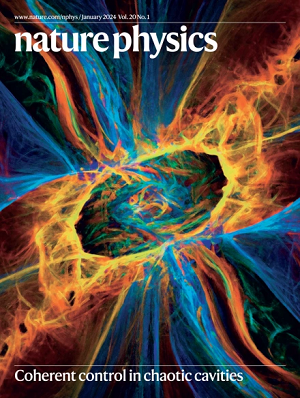受热流限制的无膜原始细胞
IF 18.4
1区 物理与天体物理
Q1 PHYSICS, MULTIDISCIPLINARY
引用次数: 0
摘要
在活细胞中,生物分子的复杂混合物在膜内和膜外组装。这种非平衡状态是由复杂的蛋白质机制维持的,它输入食物分子,清除废物并协调细胞分裂。然而,目前尚不清楚这种复杂的细胞机制是如何出现和进化的。在这里,我们展示了细胞的分子内容物如何以协调的方式耦合到非平衡热流。一个充满水的孔的温差组装了现代细胞的核心成分,然后可以激活基因表达。其机理是由同一热源驱动的对流和热泳运动相互作用产生的。通过RNA从DNA合成蛋白质的细胞机制被触发为细胞成分浓度的直接结果。同样的非平衡环境继续从相邻的流体流中吸引食物分子,使细胞分子保持在一个受限的口袋中,防止扩散。我们的研究结果表明,一个简单的非平衡物理过程如何组装细胞的许多不同分子并触发其基本功能。该框架提供了一个无膜的环境,将漫长的进化时间从RNA世界过渡到基于蛋白质的细胞样原代谢。本文章由计算机程序翻译,如有差异,请以英文原文为准。


Membraneless protocell confined by a heat flow
In living cells, a complex mixture of biomolecules is assembled within and across membranes. This non-equilibrium state is maintained by sophisticated protein machinery, which imports food molecules, removes waste products and orchestrates cell division. However, it remains unclear how this complex cellular machinery emerged and evolved. Here we show how the molecular contents of a cell can be coupled in a coordinated way to non-equilibrium heat flow. A temperature difference across a water-filled pore assembled the core components of a modern cell, which could then activate the gene expression. The mechanism arose from the interplay of convection and thermophoresis, both driven by the same heat source. The cellular machinery of protein synthesis from DNA via RNA was triggered as a direct result of the concentration of cell components. The same non-equilibrium setting continued to attract food molecules from an adjacent fluid stream, keeping the cellular molecules in a confined pocket protected against diffusion. Our results show how a simple non-equilibrium physical process can assemble the many different molecules of a cell and trigger its basic functions. The framework provides a membrane-free environment to bridge the long evolutionary times from an RNA world to a protein-based cell-like proto-metabolism. It is unclear how cell compartmentalization emerged in prebiotic conditions. Now it is shown that a temperature gradient in a confined space can bring the core components of a cell together.
求助全文
通过发布文献求助,成功后即可免费获取论文全文。
去求助
来源期刊

Nature Physics
物理-物理:综合
CiteScore
30.40
自引率
2.00%
发文量
349
审稿时长
4-8 weeks
期刊介绍:
Nature Physics is dedicated to publishing top-tier original research in physics with a fair and rigorous review process. It provides high visibility and access to a broad readership, maintaining high standards in copy editing and production, ensuring rapid publication, and maintaining independence from academic societies and other vested interests.
The journal presents two main research paper formats: Letters and Articles. Alongside primary research, Nature Physics serves as a central source for valuable information within the physics community through Review Articles, News & Views, Research Highlights covering crucial developments across the physics literature, Commentaries, Book Reviews, and Correspondence.
 求助内容:
求助内容: 应助结果提醒方式:
应助结果提醒方式:


